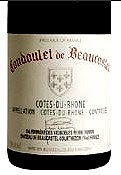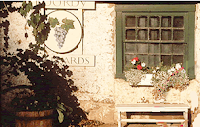As the holiday season approaches, selecting wines plays a big part in meal planning.
For some people, that’s a fun chore. For others, it’s a nightmare. For both ends of this spectrum, and for those in between, here’s a “five for the holidays” range of wines with markedly different styles and price points. And, since we do eat more than turkey and ham during the holidays, these choices reflect that as well.
 • Chateau du Rouét 2007 Cuvee Reservee
• Chateau du Rouét 2007 Cuvee Reservee
This traditional rosé comes from a winery whose chateau was owned by the Marquis de Villeneuve, supplier of wines to the court of Louis XVI. I tried it during a lunch at the home of Jeffrey Gimmel and Nina Bachinsky–Gimmel, owners of the trendy Swoon Kitchenbar in Hudson, NY, a small riverside city just north of the Big Apple.
This is a blend of grenache, mourvèdre and cinsault grapes, made by the first crush after cool skin maceration. That makes it a good accompaniment to any strongly-herbed dishes, such as the thyme-coated rotisserie poulet that was central to our meal.
Unlike the watery rosès that flooded the domestic market in the '90s and thereby ruined the category for a lot of first-timers, this is a full-bodied wine that goes well with anything from the lightness of a spring salad of lovage, chive blossoms, goat cheese and English peas to a layered potato-bacon pie.
The delicate pink color hints of the tastes to come -- lightly fruity cassis and raspberry. Not much length, but a serviceable wine for meals.
Suggested retail price: $16. • 2007 Simonassi Malbec "1922"
• 2007 Simonassi Malbec "1922"Malbec was long a minor French blending grape. Some years ago some enterprising Argentinean vintners decided their high country vineyards would be ideal for the grape they thought could stand on its own. They were right, and its popularity has been steadily growing.
This bold, rich purplish wine is visually inviting. I tried it at the Vin Santo wine and tapas bar in Latham, NY, just outside the capital city of Albany, along with a series of small plates of grilled chorizo and game sausages, New Zealand lamb chop “pops” marinated and grilled and served with Israeli couscous salad, a forest mushroom strudel and an ahi tuna sashimi served with crisp seaweed, pickled ginger, wasabi and soy sauce.
In the course of polishing off these treats, the Malbec kept opening and softening, releasing deep notes of black cherry, plum and warm spices, making it a perfect accompaniment to each item.
Suggested retail price: $19. • Arboleda Carmenère 2006
• Arboleda Carmenère 2006This rich, lush wine comes from a Chilean boutique winery located in the Colchagua Valley. It is 100% carmenère, the country's major grape.
This mid-May '06 vintage was an excellent one and this particular wine is a prime example of it. It is a big, deep-violet wine, 14.5% alcohol by volume, that begins with a pleasing assault on the nose of tobacco, cinnamon and black tea.
That complexity continues on the palate with notes of cocoa and stone fruits -- plum, black cherry and the like -- and berries plus just a touch of sweetness. Touches of cedar and vanilla imparted by the cask aging also can be discerned, and the long finish develops into a drier level of the tobacco and unsweetened chocolate.
I matched it at a home dinner with a pork tenderloin roasted in a honey-mustard sauce, sided with brown rice, steamed cauliflower, and a cold, bitey side dish of diced tomatoes, cucumbers and jalapeños marinated overnight in herbs and rice wine vinegar. The wine both stood up to and complemented each dish.
Suggested retail price: $16. • Coudoulet de Beaucastel 2003
• Coudoulet de Beaucastel 2003
Cotes du Rhone wines are big, bold and meaty, perfect for a flatiron prime beef luncheon I had with Dale Miller, one of those rare Certified Master Chefs, who is executive chef and general manager of the stately Inn at Erlowest on New York's picturesque Lake George.
This is a French red as big as its formal name: 2003 Château de Beaucastel Côtes du Rhône Coudoulet de Beaucastel. It's a blend of mourvédre, grenache, cinsault and syrah grapes, unfiltered and bursting at the seams with flavor.
I particularly like the fact that the bouquet keeps opening once poured, enhancing the notes of leather, pepper and ripe fruit. It complemented not only the sliced flatiron prime, but the vegetable terrine, grilled asparagus and roasted fingerling potatoes it accompanied at the luncheon. A splash of the wine added to the steak juice reduction tied it all together.
Suggested retail price: $34. • Bloomer Creek Vineyard 2006 Reserve White
• Bloomer Creek Vineyard 2006 Reserve White Bloomer Creek Vineyards, located in Hector in the Finger Lakes, was founded in 1999 by Kim Engle, a veteran winery manager, and his wife, artist Debra Bermingham, and went into full production in 2004. I tried this wine with an elaborate luncheon prepared by noted Indonesian chef Yono Purnomo, owner of the prestigious Yono's restaurant in Albany, NY.
It was my first intentional sampling of this product of New York's Finger Lakes region. I had voted for it as "Best of Class: Blended White Wine" in a blind-taste judging during the 2007 New York Wine & Food Classic.
This experience was just as positive. Engle's offering is an Alsatian-style Riesling blend that is at once fruity and pleasantly acidic. In other words, a Riesling that doesn't take itself too seriously but pleases nonetheless.
Kiwi, peach and a touch of pineapple come through in the middle range, and the lingering impression paired well with the Indonesian fare I consumed along with the wine: a boldly-sauced sautéed pork tenderloin, spicy shrimp and a noodle dish with chicken, shrimp and vegetables all were beautifully complemented by the wine.
Suggested retail price: $12.
To Dowd's Spirits Notebook latest entry.
To Dowd's Wine Notebook latest entry.
To Dowd's Brews Notebook latest entry.
To Dowd's Non-Alcohol Drinks Notebook latest entry.
To Dowd's Tasting Notes latest entry.
Back to Dowd On Drinks home page.
 From MSNBC.COM
From MSNBC.COM











